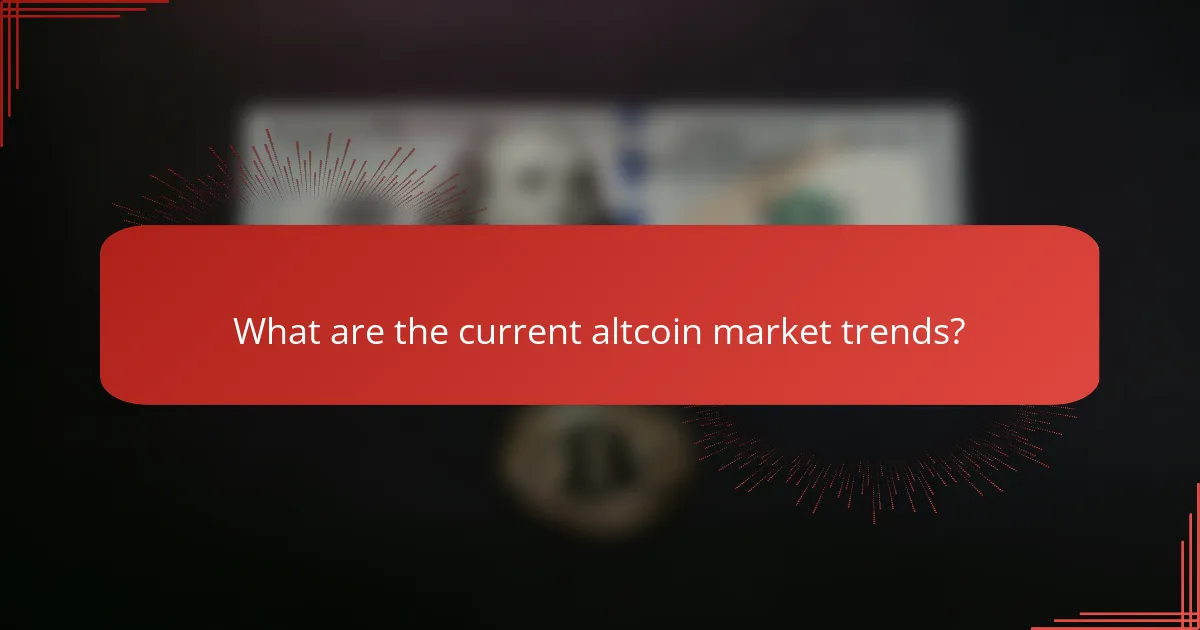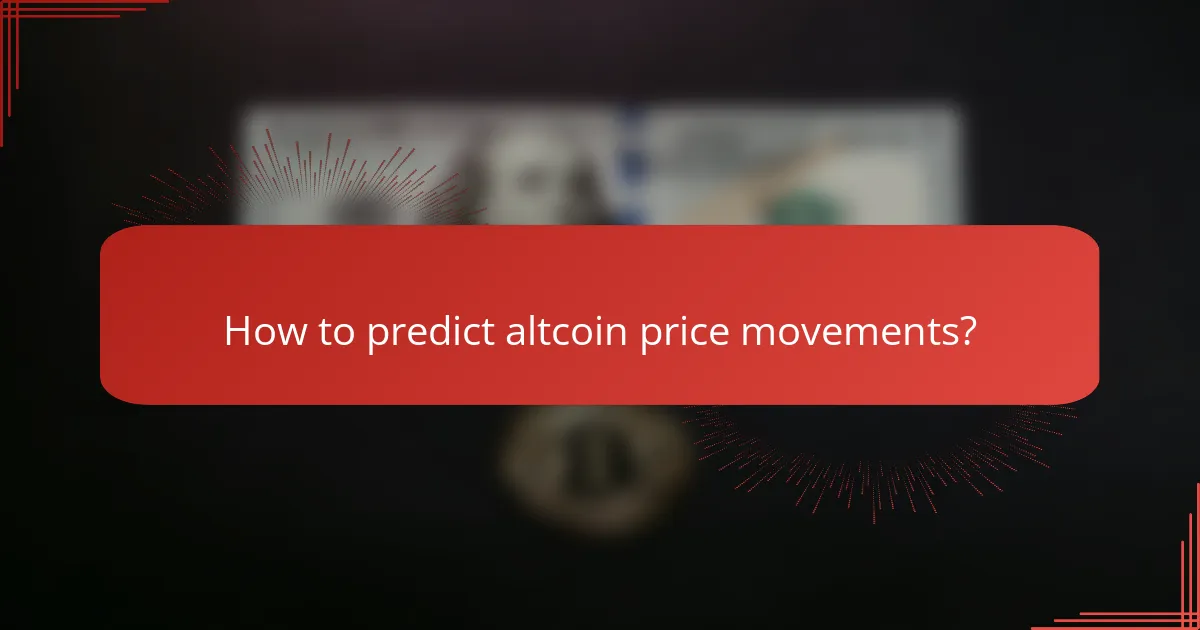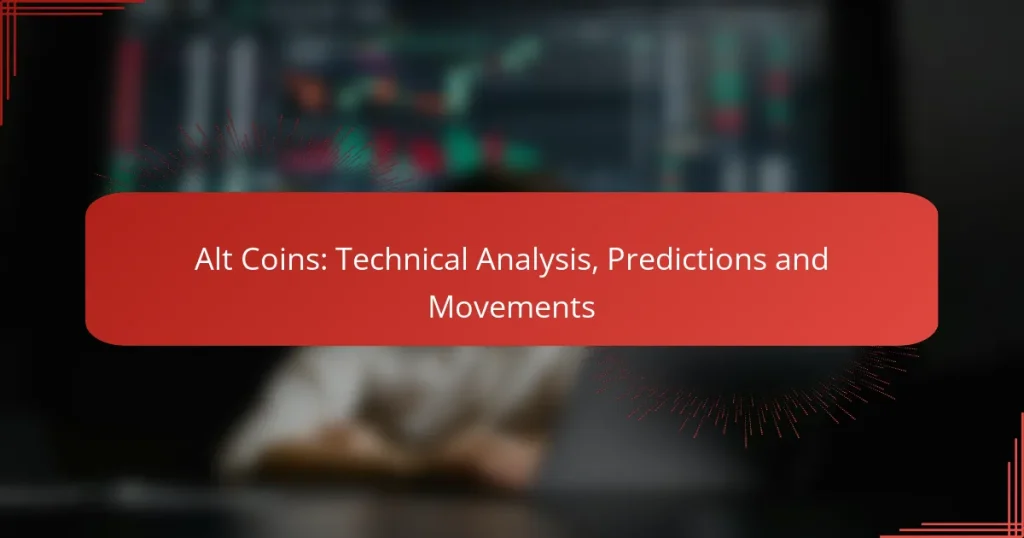As the cryptocurrency market evolves, altcoins like Ethereum, Cardano, and Solana are gaining traction for their growth potential and practical applications. Technical analysis plays a crucial role in predicting price movements, helping traders make informed decisions. With current trends leaning towards decentralized finance and NFTs, understanding these dynamics is essential for navigating the altcoin landscape effectively.

What are the best altcoins for investment in 2023?
In 2023, some of the best altcoins for investment include Ethereum, Cardano, Solana, Polkadot, and Chainlink. These cryptocurrencies have shown strong potential for growth and utility in various applications, making them attractive options for investors.
Ethereum (ETH)
Ethereum remains a leading altcoin due to its robust smart contract functionality and widespread adoption. It serves as a platform for decentralized applications (dApps) and has a strong developer community driving innovation.
Investors should consider Ethereum’s transition to a proof-of-stake model, which aims to improve scalability and reduce energy consumption. Monitoring Ethereum’s network upgrades and market trends can provide insights into its future performance.
Cardano (ADA)
Cardano is recognized for its research-driven approach and emphasis on security and sustainability. Its unique proof-of-stake consensus mechanism allows for efficient transactions and lower energy use compared to traditional models.
When investing in Cardano, pay attention to its ongoing development phases, which aim to enhance its smart contract capabilities. The platform’s partnerships and real-world use cases can also influence its growth potential.
Solana (SOL)
Solana has gained popularity for its high throughput and low transaction costs, making it suitable for decentralized finance (DeFi) applications and NFTs. Its unique architecture allows for fast processing times, often under a second.
Investors should watch for Solana’s ecosystem expansion and partnerships, as these can drive demand for its token. However, be cautious of its relatively young market presence and potential volatility.
Polkadot (DOT)
Polkadot stands out for its interoperability, allowing different blockchains to communicate and share information. This feature is crucial for the future of decentralized applications and can enhance overall blockchain functionality.
When considering Polkadot, evaluate its parachain auctions and the projects that secure slots on the network. These developments can significantly impact DOT’s value and utility in the market.
Chainlink (LINK)
Chainlink is a decentralized oracle network that connects smart contracts with real-world data, enabling them to function effectively. Its technology is essential for many DeFi projects that require reliable external information.
Investors should focus on Chainlink’s partnerships with various blockchain projects and its growing adoption in the DeFi space. Understanding its role in enhancing smart contract capabilities can provide insights into its long-term potential.

How to perform technical analysis on altcoins?
Technical analysis on altcoins involves evaluating price movements and trading volumes to forecast future price trends. By utilizing various tools and methods, traders can identify potential entry and exit points in the market.
Chart patterns
Chart patterns are visual representations of price movements that can indicate future trends. Common patterns include head and shoulders, triangles, and flags, each suggesting potential bullish or bearish movements. Recognizing these patterns can help traders make informed decisions about when to buy or sell altcoins.
For example, a bullish flag pattern may suggest a continuation of an upward trend, while a head and shoulders pattern could indicate a reversal. Traders often look for confirmation through volume spikes or other indicators before acting on these patterns.
Indicators and oscillators
Indicators and oscillators are mathematical calculations based on price and volume data that help traders assess market conditions. Popular tools include the Relative Strength Index (RSI), Moving Averages (MA), and Bollinger Bands, which provide insights into overbought or oversold conditions.
Using these tools effectively requires understanding their signals. For instance, an RSI above 70 may indicate that an altcoin is overbought, suggesting a potential price correction. Combining multiple indicators can enhance the accuracy of predictions.
Volume analysis
Volume analysis examines the number of altcoin units traded over a specific period, providing insights into market strength and potential price movements. High trading volume often confirms trends, while low volume may indicate a lack of conviction among traders.
For instance, if an altcoin’s price rises significantly with high volume, it may signal strong buying interest. Conversely, if prices increase but volume is low, it could suggest a weak trend that may not sustain. Monitoring volume alongside price movements is crucial for making sound trading decisions.

What are the current altcoin market trends?
The current altcoin market trends indicate a shift towards decentralized finance (DeFi), non-fungible tokens (NFTs), and Layer 2 solutions. These trends reflect the growing demand for innovative financial products, digital collectibles, and enhanced blockchain scalability.
DeFi growth
Decentralized finance (DeFi) has seen significant growth as users seek alternatives to traditional banking systems. Platforms like Uniswap and Aave allow users to trade, lend, and borrow without intermediaries, often yielding higher returns than conventional savings accounts.
Investors should consider the risks associated with DeFi, including smart contract vulnerabilities and market volatility. Engaging in yield farming or liquidity mining can offer high rewards, but it is crucial to conduct thorough research before participating.
NFT integration
The integration of non-fungible tokens (NFTs) into various sectors is reshaping how digital assets are perceived and traded. Artists and creators are leveraging platforms like OpenSea and Rarible to sell unique digital art, music, and collectibles, often fetching substantial prices.
When investing in NFTs, it’s essential to evaluate the underlying value and potential for appreciation. Factors such as the creator’s reputation, rarity, and market demand can significantly influence an NFT’s price. Be cautious of speculative bubbles and ensure you understand the asset before purchasing.
Layer 2 solutions
Layer 2 solutions are gaining traction as they address scalability issues faced by major blockchains like Ethereum. Technologies such as Polygon and Optimistic Rollups enable faster transactions and lower fees, making them attractive for developers and users alike.
Investors should keep an eye on projects utilizing Layer 2 solutions, as they may offer enhanced performance and user experience. However, it’s important to assess the long-term viability of these solutions, as they often depend on the underlying Layer 1 blockchain’s success and adoption.

How to predict altcoin price movements?
Predicting altcoin price movements involves analyzing various factors such as market sentiment, historical price patterns, and news impacts. By understanding these elements, traders can make more informed decisions about potential price changes.
Market sentiment analysis
Market sentiment analysis gauges the overall mood of traders and investors towards a specific altcoin. This can be assessed through social media trends, forums, and sentiment indicators that reflect bullish or bearish attitudes.
Tools like the Fear and Greed Index can help quantify sentiment, showing whether the market is overly optimistic or pessimistic. A strong bullish sentiment often precedes price increases, while bearish sentiment may signal declines.
Historical price patterns
Analyzing historical price patterns involves studying past price movements to identify trends and potential future behavior. Traders often look for recurring patterns such as head and shoulders, double tops, or support and resistance levels.
Using technical analysis tools, such as moving averages and Fibonacci retracement levels, can help traders predict where prices may move next based on historical data. Recognizing these patterns can provide insights into potential entry and exit points.
News impact assessment
News impact assessment focuses on how current events and announcements affect altcoin prices. Major news, such as regulatory changes, technological advancements, or partnerships, can lead to significant price volatility.
Traders should stay updated on relevant news sources and consider how different types of news may influence market behavior. For example, positive news can drive prices up, while negative news often results in sharp declines. Monitoring news sentiment can be crucial for making timely trading decisions.

What are the risks of investing in altcoins?
Investing in altcoins carries several risks that potential investors should consider. These include high volatility, regulatory uncertainties, and the potential for loss due to lack of liquidity or project failure.
Volatility and market fluctuations
Altcoins are known for their extreme price volatility, often experiencing significant price swings within short periods. This can lead to substantial gains, but also steep losses, making it essential for investors to be prepared for rapid market changes.
For example, an altcoin might rise by 50% in a week, only to drop by 30% the following week. Investors should assess their risk tolerance and consider setting stop-loss orders to mitigate potential losses.
Regulatory risks
Regulatory risks are a significant concern for altcoin investors, as the legal status of cryptocurrencies varies by country and can change rapidly. Some altcoins may face restrictions or outright bans, impacting their value and usability.
Investors should stay informed about the regulatory landscape in their jurisdiction and consider how potential regulations might affect their investments. Consulting with a financial advisor familiar with cryptocurrency regulations can be beneficial.
Lack of liquidity
Many altcoins suffer from low liquidity, meaning there may not be enough buyers or sellers in the market to facilitate trades without impacting the price significantly. This can make it challenging to enter or exit positions at desired prices.
Investors should research the trading volume and market capitalization of an altcoin before investing. Generally, altcoins with higher trading volumes are less risky in terms of liquidity, allowing for smoother transactions.
Project failure and scams
The altcoin market is rife with projects that may fail or turn out to be scams. Unlike established cryptocurrencies like Bitcoin or Ethereum, many altcoins lack a proven track record and may not have solid fundamentals.
To mitigate this risk, investors should conduct thorough research on the project’s team, technology, and community support. Look for established partnerships and transparent communication from the developers to gauge the project’s credibility.


